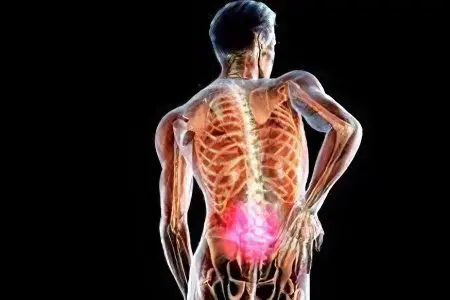Contents
If while walking you begin to suffer from lower back pain, then this is a serious reason to think about your health. Such an unfavorable symptom may indicate the development of a variety of diseases. Do not neglect the alarm bells, try to be examined in time and identify the cause of the deterioration in well-being.
Causes of back pain

Pain in the lumbar region can be provoked by the following factors:
You spend a lot of time in a sitting position (drivers, office workers)
Engaged in hard physical work with serious loads
Forced to spend the whole working day on their feet (sellers, waiters, hairdressers)
Take on excessive physical activity in the gym
Suffering from being overweight
Lower back pain often haunts women during pregnancy and after childbirth or appears during menopause, when prerequisites for the development of osteoporosis arise.
Most often, pain when walking is assessed as stabbing, throbbing, or aching. The appearance of pain, characterized as “lumbago” indicates serious problems with the spine. The causes of pain syndrome can be different. It can cause diseases of the spine, internal organs or neurological problems. Pain when walking can be the result of a cold, hypothermia, spinal overload, or be an echo of previous injuries.
Classification of back pain
Low back pain is usually divided into two types: primary and secondary.
Primary occurs due to impaired blood supply in those tissues that connect the intervertebral discs. Violations occurring in the muscles and blood vessels lead to a general weakening of the entire spine. This is manifested by pain when walking and physical exertion. Few people pay attention to these first signals of trouble, since the pains are felt as minor discomfort and are intermittent. Often, patients seek medical help only when the pain becomes unbearable, and the disease requires serious treatment or even surgery.
Secondary the type of pain occurs due to mechanical damage to muscles and tissues or the development of a tumor process. The pain is debilitating in nature and is often accompanied by a feeling of numbness and difficulty in flexion and extension of the spine. This may be a consequence not only of spinal injuries, but also indicate the presence of tumors or malignant formations of internal organs, osteochondrosis with pinched nerve roots. Therefore, if you experience pain in the lower back when walking, it is necessary to undergo a full examination as soon as possible and identify the root cause of the pathology.
Diseases that cause back pain

Osteochondrosis. It is considered the most common factor causing back pain. During the examination, degenerative changes in the spine are detected, a decrease in the height of the intervertebral discs is noted. This disturbs the mechanical balance of the structures of the spinal canal and causes pain in the lower back, which periodically occurs when walking.
Muscle spasm. Most often occurs with excessive physical exertion or prolonged body position in a statistically uncomfortable position (at the computer, squatting, bending over). Muscle spasm develops and significantly limits the mobility of the spine. Clamped muscles cause long-lasting pain and cause suffering.
Hernias. A herniated disc compresses the nerve endings of the spinal cord, resulting in constant pain that worsens in an upright position and when walking, and there are difficulties with tilting and straightening the spine.
Spinal instability. This problem is mainly observed in women of Balzac age. Instability of the vertebrae is accompanied by pain in the lower back, which is aggravated by walking or standing for a long time. There is a feeling of constant fatigue, unwillingness to make unnecessary movements and the need to lie down. This condition is caused by damage to the intervertebral joints and discs and is often accompanied by weight gain.
Narrow spinal canal. The most common symptom in this condition is lower back pain when walking, combined with pain even at rest. Pain syndrome is caused by degenerative changes in the spine associated with the growth of its articular and bone structures. This leads to infringement of the nerve endings and causes constant pain.
Examination will help to understand the cause of lower back pain. If your back does not give you rest, and pain is haunted even when walking, you need to seek medical help in a timely manner. A competent specialist will determine the cause and select the correct treatment tactics.
Diagnosis of back pain
For back pain that occurs when walking, it is necessary to undergo magnetic resonance imaging (MRI) and computerized (CT) diagnostics. MRI will assess the condition of soft tissues, and CT will show changes in the bone structures of the spine. In addition, to exclude radiating pain, doctors recommend doing an ultrasound of the internal organs. Another inexpensive and affordable diagnostic method – radiography allows you to notice even the most minor violations in the structure of the spine in the pictures. Sometimes, to clarify the diagnosis, the doctor may prescribe additional studies and tests.
Treatment methods for low back pain

After establishing the diagnosis and determining the causes of back pain, the specialist can prescribe the following set of therapeutic measures:
Blockade with drugs in the cavity of the intervertebral joints or in the region of the spinal canal
Drug therapy with hormones, analgesics, anti-inflammatory drugs
Manual therapy sessions
Physiotherapy, acupuncture, therapeutic exercises
Surgery
In any case, when pain occurs, it is necessary to undergo a diagnosis and seek advice from a neurologist or vertebrologist. The specialist will diagnose and determine the cause of the pain syndrome. This will help you get timely and proper treatment.









